
Last Updated on March 9, 2023
Time change can be hard on your internal clock–spring forward or fall back with ease when you follow these 6 easy tips.
Go to bed at the same time
Help your body acclimate to the new time quicker by going to bed at the same time you were before daylight savings time. If you know this might be a challenge, consider adjusting bedtime by 15 minutes a night a few days prior to daylight savings time to help your internal clock get back on track.
Go outside first thing in the morning
Did you know that getting daylight first thing in the morning can help set your biological clock? Getting outside for 5 minutes in the morning can not only help if you have trouble sleeping at night, but can also help you move past the awkward adjustment phase in the weeks following daylight savings time.
Take a nap
Use daylight savings as an excuse to take a short cat nap this Sunday to help your body adjust to the lost hour of sleep. Cap the nap around 15-20 minutes to receive maximum benefits.
Avoid caffeine in the evening
If you’re an avid coffee or cola drinker it’s best to reserve those beverages for the morning hours to help you get better sleep. Experts recommend quitting caffeinated beverages at least 6 hours before bedtime to promote better sleep.
Move your workout to the morning
While exercising can certainly promote better sleep, exercising too late in the day can make falling asleep at night harder. If you typically work out in the evenings, consider moving those sweat sessions to earlier in the day, as your body adjusts to daylight savings.
Avoid screens before bedtime
Wind down easier at night by avoiding screens 1-2 hours before bedtime. This practice helps stimulate melatonin (the hormone responsible for sleep). If you must be on a screen close to bedtime, consider purchasing some inexpensive blue light blocking glasses.



